Scroll to:
Investigation of the Optimal Vacuum Depth Created by an Ejector Depending on the Value of the Supply Pressure
https://doi.org/10.23947/2687-1653-2025-25-1-43-51
EDN: MPXOWG
Abstract
Introduction. Vacuum ejectors operating on the Venturi principle are used in various industries and are essential pneumatic devices. An important characteristic of a vacuum ejector is the vacuum depth it creates, where the maximum vacuum value is obtained in a certain range of supply pressure. Failure to comply with the supply pressure affects the performance of the ejector itself and automated vacuum systems in general. One of the options for solving this problem is to establish the recommended range of supply pressure in a fairly narrow pressure range, at which a guaranteed value of vacuum depth is reached without using the maximum capabilities of the ejector. At the same time, the technical literature does not provide the values of the dependence of the vacuum depth on the supply pressure over the entire range of ejector operation, which the authors would like to draw attention to in this work. The research objective was to conduct experimental studies on establishing the true values of the maximum vacuum depth depending on the magnitude of the ejector input pressure.
Materials and Methods. To conduct experimental research, a special stand was designed, manufactured and used, which allowed for the study of vacuum ejectors operating on the basis of the Venturi principle. This stand provided setting the exact vacuum value depending on the input supply pressure for ejectors with a nozzle diameter from 0.1 to 4.0 mm, which completely covered the entire range of ejectors used in real sectors of the economy. Vacuum ejectors of the VEB, VEBL, VED and VEDL families manufactured by Camozzi were investigated in the range of the inlet supply pressure of the ejector from 2.0 to 6.5 bar. The true values of the vacuum depth were determined experimentally depending on the value of the input supply pressure for each ejector, as well as the maximum values of the vacuum depth reached by each ejector at the corresponding value of the input supply pressure.
Results. It was experimentally proved that the recommended values of the input supply pressure given in the catalogs of ejector manufacturers did not always correspond to the true values. It was shown that the character of the obtained graphs also differed. In this regard, it was necessary to adjust the value of the input supply pressure to reach the maximum vacuum depth for each type of ejector.
Discussion and Conclusion. The results of the conducted experimental studies allow for a rational choice of vacuum ejectors depending on the required technological tasks. This will ensure the operability of automated vacuum systems and the performance of the ejector itself. The research results can be used by all ejector manufacturers to adjust their basic catalogs and relevant recommendations for the use of these products.
For citations:
Savchuk S.I., Umerov E.D., Abdulgazis A.U. Investigation of the Optimal Vacuum Depth Created by an Ejector Depending on the Value of the Supply Pressure. Advanced Engineering Research (Rostov-on-Don). 2025;25(1):43-51. https://doi.org/10.23947/2687-1653-2025-25-1-43-51. EDN: MPXOWG
Introduction. Currently, in various industries, the technological movement of products and parts is carried out using industrial robots equipped with vacuum suction cups, whose operation is performed using an ejector [1] based on the Venturi principle. Manufacturers offer a wide range of ejectors [2][3], which create a vacuum of varying depth depending on the supply pressure [4], which meets the specific needs of production.
The optimum value of the air supply pressure at the inlet of the ejector, at which the maximum vacuum depth is reached, can be defined as the optimum pressure. Deviation of this pressure from the specified value causes a decrease in the vacuum depth, which, in turn, negatively affects the performance of both the ejector and the suction cup, and also increases energy costs. Thus, providing optimal supply pressure for the ejector in order to reach maximum productivity and reduce energy costs becomes an urgent task.
When studying ejectors from manufacturers such as Camozzi, Festo, Schmalz, SMC Pneumatics, and others, it has been noted that only a small number of manufacturers publish in their catalogs the exact vacuum values depending on the supply pressure for different types of ejectors. The information is mainly presented in the form of a general diagram corresponding to the entire range of ejectors of a certain type, without taking into account the diameter of their nozzles.
The practical experience of the authors of the article, as well as long-term cooperation with various production sites using vacuum ejectors, made it possible to identify significant discrepancies between the true and tabulated values of supply pressures and the corresponding values of vacuum depth. Therefore, studies aimed at determining the exact dependences of the maximum vacuum depth created by the ejector on the input supply pressure, with the aim of reaching minimum energy costs, are of considerable interest. A more in-depth study of these parameters is possible using a specially created experimental stand, which allows for a high degree of accuracy in determining the specified parameters, which, in turn, can contribute to an increase in the productivity of the entire system.
Numerous studies are devoted to the use of vacuum ejectors [5] and vacuum technology [6]. The authors draw attention to the theory of vacuum [7] and its physical foundations [8], but do not sufficiently focus on the practical side of its use. In [9], specific cases of practical application of vacuum are considered; in [10], experimental studies with an improved ejector nozzle are presented; and in [11] — flow modeling. However, in modern scientific literature, practically no attention is paid to issues concerning the dependence of the magnitude of the resulting vacuum on the input supply pressure and the parameters of vacuum ejectors. Descriptions of the characteristics of vacuum ejectors can be found mainly in reference literature, such as catalogs of vacuum equipment manufacturers, for example, the Italian company Camozzi or the German company Schmalz.
In [12], it was proposed to change the geometric dimensions of the ejector nozzle, which allowed increasing their productivity. In experimental work [13], the results of a study were presented in which the angle of inclination of the ejector mixing chamber was changed, which also contributed to increasing its productivity. In [14], the author attempted to study the main characteristics of vacuum ejectors and proposed a methodology for experimental research, which received a logical continuation in [15].
Taking into account all of the above, the authors set themselves the objective of conducting experimental studies to determine the true values of the maximum vacuum depth depending on the magnitude of the ejector input pressure.
Materials and Methods. To conduct full-scale studies of vacuum ejectors, a special stand [15] was used. It was developed by the authors of the article and presented in Figure 1.
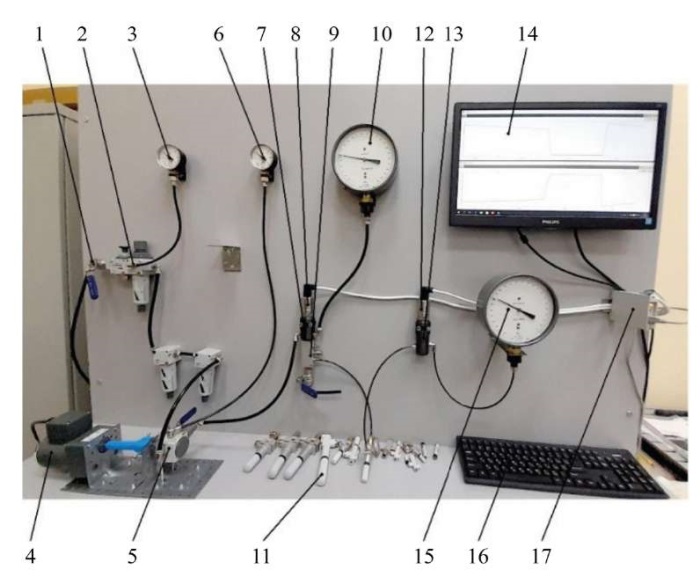
Fig. 1. Stand for conducting experimental research
Table 1
Components of Stand for Conducting Experimental Studies
|
Designator |
Type/Model |
|
|
1 |
Air inlet valve |
Ball valve V2E-316-PP-1/4 |
|
2 |
Inlet unit |
Modular air preparation unit MC104-N-5-FL |
|
3 |
Control pressure gauge |
Pressure gauge M063-R12 |
|
4 |
Electronic drive with regulator |
Gear motor 80YT25WGV22H/80GK150H with controller WS-L (25W) |
|
5 |
Main regulator with shut-off valve |
Pressure regulator МС104-R05 with ball valve V2E-316-PP-1/4 |
|
6 |
Control pressure gauge |
Pressure gauge M063-R12 |
|
7 |
Tee |
|
|
8 |
Pressure sensor |
Pressure sensor MIDA-DI-15-RS485-0.15(0.25; 0.5)/0-1.6 MPa-064-M20-DIN C |
|
9 |
Distribution manifold |
Manifold 3053 1/4-3L-1/8 |
|
10 |
Control manometer |
Standard deformation manometer with conditional scale, model 11202, accuracy class 0.4 16 kgf/cm²); SM |
|
11 |
Tested ejector |
|
|
12 |
Absolute pressure sensor |
Pressure sensor MIDA-DA-15-RS485-0.15(0.25; 0.5)/0-0.1 MPa-064-M20-DIN C |
|
13 |
Tee |
|
|
14 |
Computer monitor |
|
|
15 |
Control vacuum gauge |
Standard deformation vacuum gauge with conditional scale, model 11201, accuracy class 0.4 (-0.1 MPa); SVG |
|
16 |
Computer |
Only the keyboard is shown conditionally |
|
17 |
Sensor controller |
Communication device MIDA-US-410 |
The study examined the VEB, VEBL, VED and VEDL vacuum ejectors manufactured by Camozzi [8] in the range of input pressure feeding the ejector from 2.0 to 6.5 bar. The main objective of the study was to establish the true values of the vacuum depth depending on the magnitude of the input supply pressure for each of the ejectors. In addition, it was necessary to experimentally determine the maximum vacuum depth values that each of the ejectors was capable to reach, as well as the input supply pressure corresponding to these vacuum depth values. The parameters obtained will subsequently be needed to conduct the following series of experiments aimed at establishing the time of creating vacuum in a volume of one liter at various specified vacuum depths.
For each ejector from the families under consideration, at least 17 experiments were conducted. In this case, for each individual experiment, its own fixed rotation speed of the flywheel of the main pressure regulator 5 was set. The purpose of these settings was to provide maximum smoothness of the change in parameters, as well as to exclude the omission of any significant events during the experiment.
Research Results. Below are the graphs of the dependence of the change in vacuum depth on the value of the supply pressure obtained as a result of the experiment for the ejector series (Fig. 2–5). The comparison of the obtained data with similar parameters of the ejectors provided in the Camozzi catalog is also performed.
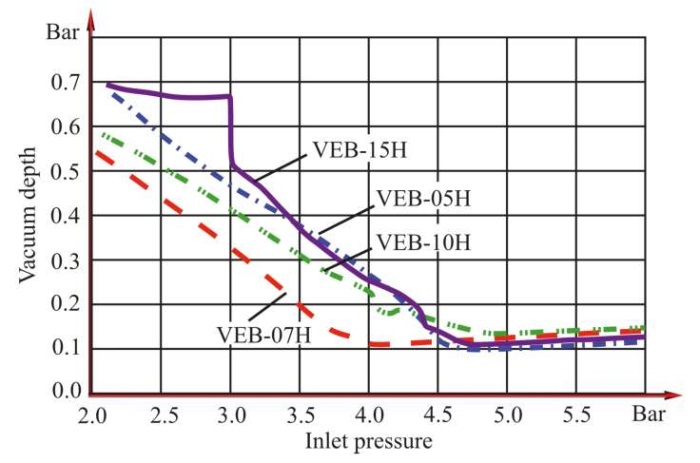
Fig. 2. Vacuum depth change dependence diagrams from the supply pressure value for VEB series ejectors
As for the VEB-07H ejector, the experimental data has shown that its vacuum depth reaches 89.34% (residual pressure 108 mbar) at a supply pressure in the range of 4.07–4.08 bar. Comparing with the data provided by the manufacturer for the VEB-07H ejector, it is found that the optimal supply pressure for this device is also 4.5 bar, at which the vacuum depth should be 85% (residual pressure 152 mbar). This value does not correspond to the values presented in the company's catalog, which shows the dependence of the change in vacuum depth on the value of the supply pressure for VEB family ejectors. It is found that at a supply pressure of 4.5 bar (recommended value for operating the VEB-07H ejector), the vacuum depth reaches 88.65% (residual pressure 115 mbar). Thus, the existing discrepancies between the experimental data and the information provided by the manufacturer require additional analysis and may indicate the need to revise the recommended operating parameters of the ejectors.
It has been experimentally established that for the VEB-10H ejector, the vacuum depth reaches 86.9% (residual pressure 132.6 mbar) at a supply pressure of 4.9 bar. The data provided by the manufacturer of the VEB-10H ejector indicate that the optimal supply pressure is 5 bar, while the vacuum depth should reach 85% (residual pressure 152 mbar). This value corresponds to the dependence diagram presented in the manufacturer's catalog, which demonstrates the change in vacuum depth depending on the value of the supply pressure for VEB family ejectors. In the course of the study, the authors have found that for the VEB-10H ejector at a supply pressure of 5 bar (the value recommended as optimal for the operation of this device), the vacuum depth reaches 86.8% (residual pressure 133.5 mbar).
Of particular interest is the unusual behavior of the dependence graph in the supply pressure range from 4 to 4.2 bar (Fig. 3).
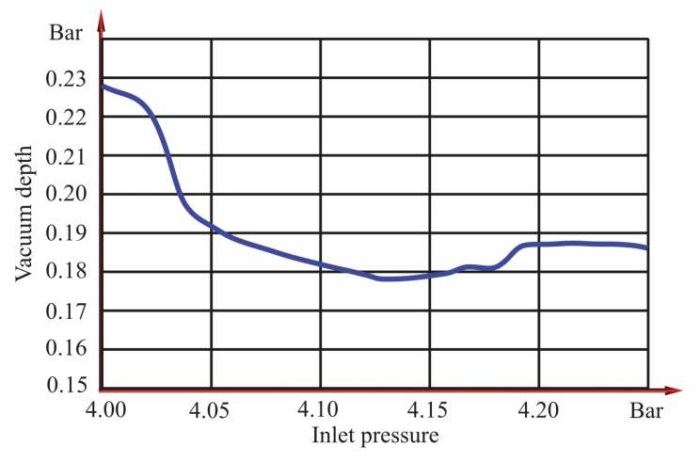
Fig. 3. Unusual behavior of the graph
For the VEB-15H ejector, it has been experimentally established that the vacuum depth reaches 89.24% (residual pressure 109 mbar) at a supply pressure of 4.75 bar. The data provided by the manufacturer of the VEB-15H ejector indicate that the optimal supply pressure is 4.5 bar, provided that the vacuum depth reaches 85% (residual pressure 152 mbar). This value probably corresponds to the diagram presented in the company's catalog, which demonstrates the dependence of the change in the vacuum depth on the value of the supply pressure for the VEB family of ejectors. In the course of the studies, it has been found that for the VEB-15H ejector, with a supply pressure of 4.5 bar recommended by the manufacturer as optimal for its operation, the vacuum depth reached 85.69% (residual pressure 145 mbar).
Particular attention should be paid to the sharp drop in vacuum values in the supply pressure range from 2.95 to 3.0 bar (Fig. 2). The reasons for this behavior of the graph are expected to be studied in the future as part of the development of a mathematical model of the ejector.
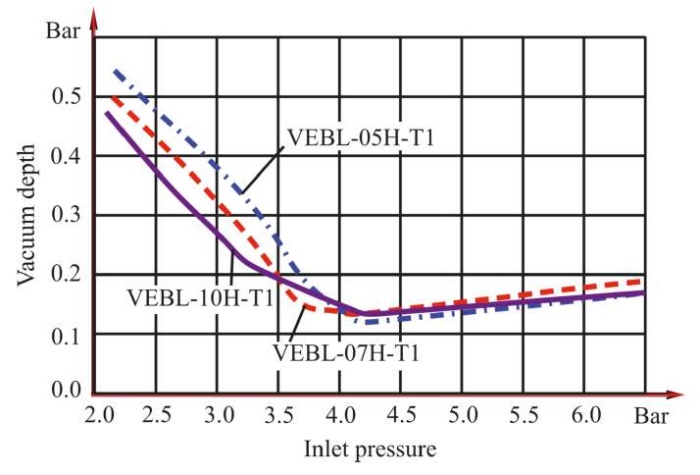
Fig. 4. Vacuum depth change dependence diagrams from the value of the supply pressure for VEBL series ejectors
The experimental data analysis shows that for the VEBL-05N-T1 ejector, the vacuum depth reaches 88.06% (residual pressure 121 mbar) at a supply pressure of 4.2 bar.
The information from the manufacturer on the VEBL-05N-T1 ejector indicates that the optimal supply pressure is 4.5 bar, while the residual pressure in the vacuum line should reach 160 mbar. The data correspond to the graphs presented in the manufacturer's catalog, which demonstrate the dependence of the change in vacuum depth on the supply pressure value for VEBL family ejectors. In the course of the conducted research, it has been established that for the VEBL-05N-T1 ejector with a recommended supply pressure of 4.5 bar, the residual pressure in the vacuum line is 127 mbar, which corresponds to a vacuum depth of 87.47%.
For the VEBL-07N-T1 ejector, it has been experimentally established that the minimum residual pressure in the vacuum line reaches 133 mbar (86.87%) at a supply pressure of 4.1 bar.
The data provided by the manufacturer for the VEBL-07N-T1 ejector, indicate an optimal supply pressure of 4.5 bar. At the same time, the residual pressure in the vacuum line should reach 150 mbar. This value is confirmed by the diagram provided in the manufacturer's catalog, which illustrates the dependence of changes in the vacuum depth on the supply pressure for VEBL family ejectors. The results of the conducted studies show that for the VEBL-07N-T1 ejector, with a supply pressure of 4.5 bar recommended by the manufacturer as optimal for its operation, the residual pressure in the vacuum line is 142 mbar, which corresponds to a vacuum depth of 85.99%.
As for the VEBL-10N-T2 ejector, it has been experimentally established that the minimum residual pressure in the vacuum line reaches 133 mbar, which corresponds to a vacuum depth of 86.87% with a supply pressure of 4.22 bar. The data, provided by the manufacturer for the VEBL-10N-T2 ejector, indicate an optimal supply pressure of 4.5 bar, while the residual pressure in the vacuum line should reach 150 mbar. This value corresponds to the diagram presented in the manufacturer's catalog, which illustrates the dependence of changes in the vacuum depth on the value of the supply pressure for the VEBL family of ejectors. The conducted studies show that for the VEBL-10N-T2 ejector, with the manufacturer's recommended supply pressure of 4.5 bar, the residual pressure in the vacuum line is 138 mbar, which translates into a vacuum depth of 86.38%.
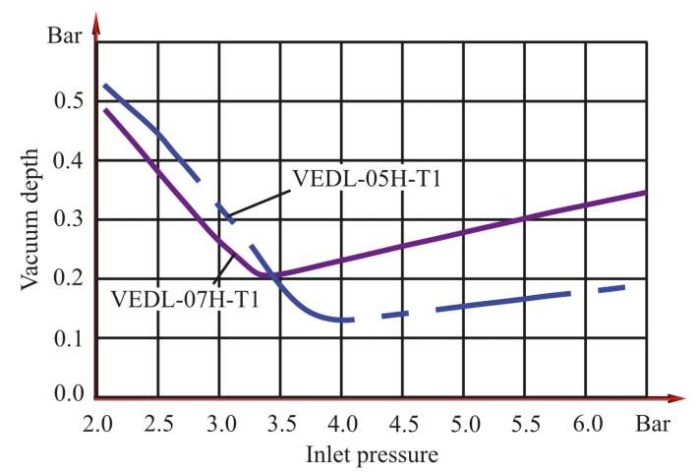
Fig. 5. Vacuum depth change dependence diagrams from the feed pressure value for VEDL series ejectors
The experimental data analysis shows that for the VEDL-05N-T1 ejector, the minimum residual pressure in the vacuum line reaches 130 mbar (vacuum depth 87.17%) at a supply pressure of 4.0 bar. The data, provided by the manufacturer for the VEDL-05N-T1 ejector, indicate an optimal supply pressure of 4.5 bar, while a residual pressure of 170 mbar should be reached in the vacuum line. This value corresponds to the diagram of the dependence of the change in the vacuum depth on the value of the supply pressure for the VEDL family of ejectors given in the manufacturer's catalog. The conducted studies show that for the VEDL-05N-T1 ejector with a feed pressure of 4.5 bar (the value recommended by the manufacturer as optimal for the operation of the VEDL-05N-T1 ejector), the residual pressure in the vacuum line is 142.6 mbar, which corresponds to a vacuum depth of 85.99%.
It has been experimentally established that for the VEDL-07N-T1 ejector, the minimum residual pressure in the vacuum line reaches 207 mbar (79.57%) at a supply pressure of 3.4 bar. The data provided by the manufacturer for the VEDL-07N-T1 ejector indicate an optimal supply pressure of 4.5 bar, while the residual pressure in the vacuum line should reach 150 mbar. This value corresponds to the diagram of the dependence of the change in the vacuum depth on the value of the supply pressure for the VEDL family of ejectors given in the manufacturer's catalog. The conducted studies show that for the VEDL-07N-T1 ejector at a supply pressure of 4.5 bar (the value recommended by the manufacturer as optimal for the operation of the VEDL-07N-T1 ejector), the residual pressure in the vacuum line is 256 mbar, which corresponds to a vacuum depth of 74.73%.
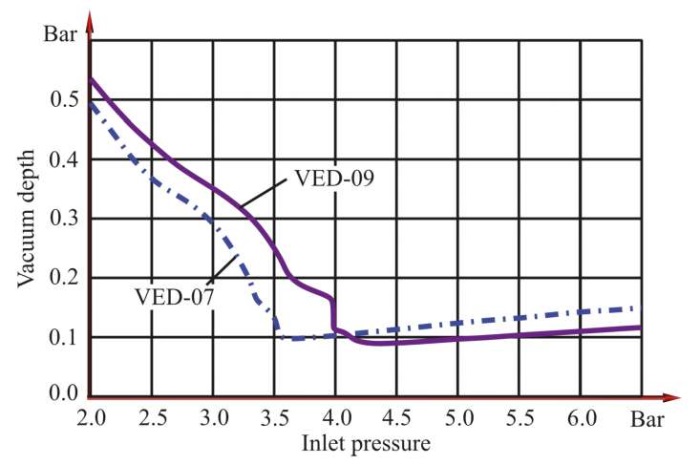
Fig. 6. Vacuum depth change versus supply pressure diagrams for VED series ejectors.
The experimental data analysis shows that for the VED-07 ejector, the minimum residual pressure in the vacuum line reaches 98 mbar (90%) at a supply pressure of 3.63 bar. The data provided by the manufacturer for the VED-07 ejector indicate an optimal supply pressure of 5 bar, in which case a vacuum of 90% should be reached (residual pressure of 101 mbar). This value does not correspond to the diagram of the dependence of the change in the vacuum depth on the value of the supply pressure for the VED family of ejectors given in the manufacturer's catalog. The conducted studies show that for the VED-07 ejector at a supply pressure of 5 bar (the value recommended by the manufacturer as optimal for the operation of the VED-07 ejector), the residual pressure in the vacuum line is 124 mbar, which corresponds to a vacuum depth of 87.76%.
It has been experimentally established that for the VED-09 ejector, the minimum residual pressure in the vacuum line reaches 90 mbar (91.12%) at a supply pressure of 4.34 bar. The data provided by the manufacturer for the VED-09 ejector, indicate an optimal supply pressure of 5 bar, in which case a vacuum of 89% depth should be reached (residual pressure 111.5 mbar). This value does not correspond to the diagram of the dependence of the change in the vacuum depth on the value of the supply pressure for the VED family of ejectors given in the manufacturer's catalog. The conducted studies show that for the VED-09 ejector at a supply pressure of 5 bar (the value recommended by the manufacturer as optimal for operation of the VED-09 ejector), the residual pressure in the vacuum line is 98 mbar, which corresponds to a vacuum depth of 90.33%.
Of interest is the sharp drop in the vacuum depth value and the occurrence of fluctuations in the vacuum depth readings in the range of supply pressure values from 3.95 to 4.4 bar (Fig. 6).
Discussion and Conclusion. The moment of occurrence of oscillations, recorded during all experiments, was accompanied by noticeable changes in the exhaust sound. We believe that this type of behavior may be associated with a sharp change in the air flow pattern, which may indicate the presence of a manufacturing flaw in this ejector. To confirm this conclusion, it is necessary to conduct additional experiments with other ejectors from this series. Furthermore, it is worth considering the possibility of studying the surface of the ejector channel in order to assess the accuracy of geometric shapes and the quality of surface treatment.
According to the results of the conducted experimental studies of vacuum ejectors, it can be concluded that the actual values of the vacuum depth vary depending on the magnitude of the input supply pressure, and differ from the values provided by the manufacturer. In addition, the character of the graphs also has its own differences. Specifically, the behavior of the graph in Figure 3 indicates the possible presence of manufacturing flaw in the ejector channel. In this regard, it is important to construct a mathematical model of ejectors, which allows us to study the factors that determine such a specific behavior of the graph at the model level. Understanding these factors will help develop recommendations for improving the technological processes of manufacturing vacuum ejectors.
In this regard, it is necessary to introduce an adjustment to the value of the input supply pressure to reach the maximum vacuum depth for each type of ejector, which will affect the performance of both the ejectors themselves and the automated vacuum systems.
The research results obtained can be useful for all ejector manufacturers for the purpose of adjusting their basic catalogs and corresponding recommendations for the use of these products. In the future, the authors plan to continue a series of experiments aimed at determining the time of creating vacuum in one liter of volume at various specified vacuum depths.
References
1. Li Macia, Castilla R, Gamez-Montero PJ, Camacho S, Codina E. Numerical Simulation of a Supersonic Ejector for Vacuum Generation with Explicit and Implicit Solver in Openfoam. Energies. 2019;12(18):3553. https://doi.org/10.3390/en12183553
2. Besagni G, Mereu R, Inzoli F. Ejector Refrigeration: A Comprehensive Review. Renewable and Sustainable Energy Reviews. 2016;53:373–407. https://doi.org/10.1016/j.rser.2015.08.059
3. Arun Kumar R, Rajesh G. Physics of Vacuum Generation in Zero-Secondary Flow Ejectors. Physics of Fluids. 2018;30(6):066102. https://doi.org/10.1063/1.5030073
4. Jafarian A, Azizi M, Forghani P. Experimental and Numerical Investigation of Transient Phenomena in Vacuum Ejectors. Energy. 2016;102:528–536. https://doi.org/10.1016/j.energy.2016.02.101
5. Levchenko D, Meleychuk S, Arseniev V. Regime Characteristics of Vacuum Unit with a Vortex Ejector Stage with Different Geometry of Its Flow Path. Procedia Engineering. 2012;39:28–34. https://doi.org/10.1016/j.proeng.2012.07.004
6. Kumar V, Sachdeva G. 1-D Model for Finding Geometry of a Single Phase Ejector. Energy. 2018;165(A):75–92. https://doi.org/10.1016/j.energy.2018.09.071
7. Sobolev AV. Intensification of Mixing by Small-Size Jets in Ejectors with Central Nozzle. Thermophysics and Aeromechanics. 2013;20(3):273–276. URL: https://link.springer.com/article/10.1134/S0869864313030025 (accessed: 10.11.2024).
8. Karthick SK, Srisha MV Rao, Jagadeesh G, Reddy KPJ. Parametric Experimental Studies on Mixing Characteristics within a Low Area Ratio Rectangular Supersonic Gaseous Ejector. Physics of Fluids. 2016;28(7):076101. https://doi.org/10.1063/1.4954669
9. Hesse S. Compressed Air as an Energy Carrier. Moscow: Festo; 2004. 128 p. (In Russ.)
10. Goodman N, Leege BJ, Johnson PE. An Improved de Laval Nozzle Experiment. International Journal of Mechanical Engineering Education. 2021;50(2):513–537. https://doi.org/10.1177/03064190211034165
11. Moukalled F, Mangani L, Darwish M. The Finite Volume Method in Computational Fluid Dynamics. Springer: Cham; 2016. 791 p. https://doi.org/10.1007/978-3-319-16874-6
12. Jia Yan, Shengyu Li, Zhan Liu. Numerical Investigation on Optimization of Ejector Primary Nozzle Geometries with Fixed/Varied Nozzle Exit Position. Applied Thermal Engineering. 2020;175:115426. https://doi.org/10.1016/j.applthermaleng.2020.115426
13. Kun Zhang, Shengqiang Shen S., Yong Yang, Xingwang Tian. Experimental Investigation of Adjustable Ejector Performance. Journal of Energy Engineering. 2011;138(3):125–129. https://doi.org/10.1061/(ASCE)EY.1943-7897.0000058
14. Savchuk SI. Study of parameters of Vacuum Ejectors Used in the Assembly and Repair of Cars. Scientific Notes of the Crimean Engineering and Pedagogical University. 2016;53(3):58–64. URL: https://uz.kipu-rc.ru:9443/sn/53.pdf (accessed: 28.11.2024).
15. Savchuk SI, Umerov ED, Abdulgazis UA. A Stand for Assessing the Depth of Vacuum Supplied to Specialized Suction Cups Used in Technological Processes of Service during Operation and Production of Cars. Scientific Notes of the Crimean Engineering and Pedagogical University. 2023;82(4):225–230.
About the Authors
S. I. SavchukRussian Federation
Sergey I. Savchuk, Cand.Sci. (Eng.), Associate Professor of the Motor Transport Department
8, Uchebnyi Lane, Simferopol, 295015, Republic of Crimea
E. D. Umerov
Russian Federation
Ervin D. Umerov, Cand.Sci. (Eng.), Associate Professor of the Motor Transport Department
Scopus ID: 57197734041
Researcher ID: Q-3875-2018
8, Uchebnyi Lane, Simferopol, 295015, Republic of Crimea
A. U. Abdulgazis
Russian Federation
Aziz U. Abdulgazis, Cand.Sci. (Eng.), Associate Professor of the Motor Transport Department
8, Uchebnyi Lane, Simferopol, 295015, Republic of Crimea
Review
For citations:
Savchuk S.I., Umerov E.D., Abdulgazis A.U. Investigation of the Optimal Vacuum Depth Created by an Ejector Depending on the Value of the Supply Pressure. Advanced Engineering Research (Rostov-on-Don). 2025;25(1):43-51. https://doi.org/10.23947/2687-1653-2025-25-1-43-51. EDN: MPXOWG












































